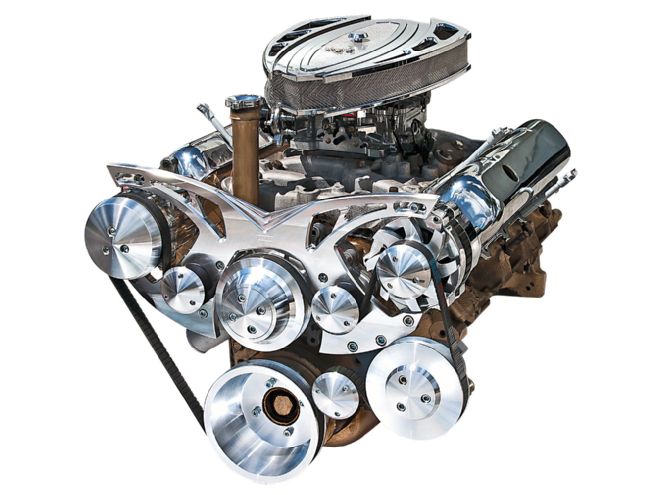
In an earlier Pit Stop, Ryan Walker asked where he could get a serpentine beltdrive system for a Pontiac 400 (“‘Real’ Pontiac V8 Serpentine Drive,” Aug. 2013). I’m working on two Olds projects: One is a ’37 Coupe with a ’70 Olds 350 and the other a COE hauler truck with a ’70 Olds 455. Olds engines look real close to a Pontiac, and I think some of the brackets mentioned in the earlier column might interchange with some mods. I’m not afraid to modify, as most of my parts are scratch-built anyway. What is the A/C (air conditioning) bracket in the photo off of, and where can I get one? What else might interchange?
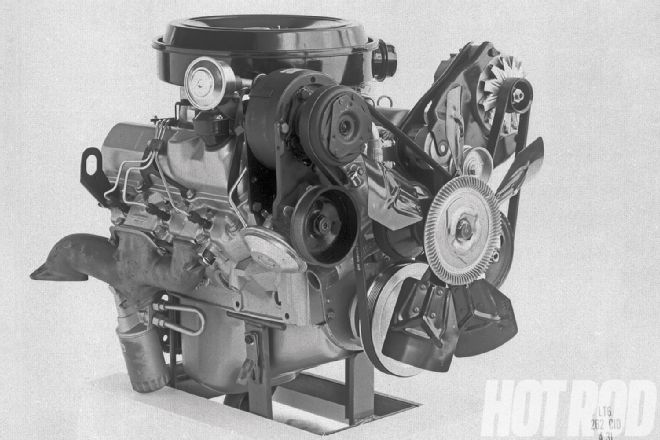 This is an official GM photo of the rare ’82–’84 Olds LT6 4.3L/262ci diesel V6, complete with the very first GM serpentine-drive. If you can find one, it could serve as the basis for a home-brewed serpentine system for a traditional Olds gasoline V8 engine. Note the engine-driven vacuum pump and (look real close and trace the belt-routing) a reverse-rotation water pump. Pic: GM Powertrain
This is an official GM photo of the rare ’82–’84 Olds LT6 4.3L/262ci diesel V6, complete with the very first GM serpentine-drive. If you can find one, it could serve as the basis for a home-brewed serpentine system for a traditional Olds gasoline V8 engine. Note the engine-driven vacuum pump and (look real close and trace the belt-routing) a reverse-rotation water pump. Pic: GM Powertrain
The Olds and Pontiac V8 engines are completely different designs. Some of the individual engine-driven components, such as the power-steering pump and the alternator (as well as pulleys for those devices), may interchange. However, the mounting brackets for them definitely won’t interchange. The specific A/C bracket referenced in the Aug. ’13 Pit Stop is a custom Rodney Red part designed for use on its own Pontiac serpentine-drive kit. However, Rodney’s willing to sell just the bracket to those who wish to try adapting it for use on a one-off custom rig.
In your case, there’s no need to entirely reinvent the wheel. Believe it or not, once upon a time there really was a stock GM Olds serpentine-drive setup for its traditional engine architecture. It was arguably the very first GM serpentine system and could serve as a starting point for building a serpentine setup for other traditional Olds V8 engines. Forget about trying to buy the parts new from a GM dealer (they’re long discontinued), but if scouring the wrecking yard, look for an ’82–’84 rear-drive Cutlass (or equivalent G-body clones sold by other GM divisions) with the rare RPO LT6 4.3L Olds V6 diesel engine (VIN code “V”). There were also transverse front-wheel-drive versions of this engine in the same time-frame with their own serpentine system, but they’re not suitable for a conventional longitudinal engine installation.
Why should you care about a weirdo V6 diesel? Because it’s a cousin of the 350 Olds diesel V8, which in turn was an offshoot of a standard Olds small-block gasoline-fueled V8. Olds diesel/gas engine front ends are nearly identical. However, as the serpentine app is both a V6 and a diesel, any braces or brackets that bolt to the intake manifold will almost certainly need modification. The old parts book illustrations indicate that at least one bracket ran from the A/C over to the intake. On a 455 or other big-block Olds, there would also be deck-height differences to contend with.
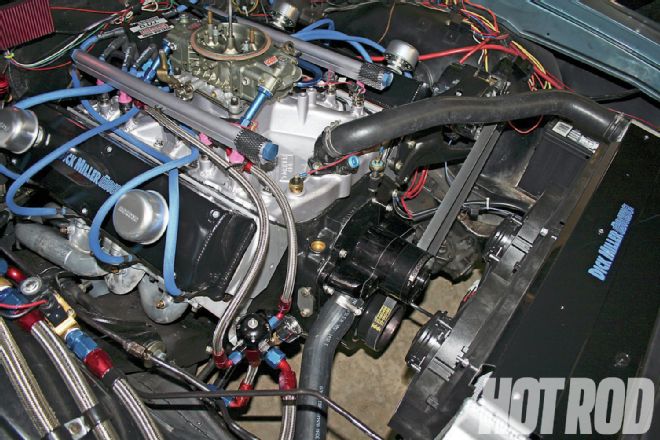 As seen on Dick Miller’s own ’70 W31 Cutlass now running a 735hp big-block Olds, the DMR drives uses stock brackets and accessories. This variant drives only the alternator 20 percent under to clear a Meziere electric water pump. With a Be Cool radiator and twin electric fans, Miller says the car “makes back-to-back 6-second runs and never gets over 180 degrees.”
As seen on Dick Miller’s own ’70 W31 Cutlass now running a 735hp big-block Olds, the DMR drives uses stock brackets and accessories. This variant drives only the alternator 20 percent under to clear a Meziere electric water pump. With a Be Cool radiator and twin electric fans, Miller says the car “makes back-to-back 6-second runs and never gets over 180 degrees.”
V6 diesels were available with or without A/C (the compressor was the GM corporate R4 “shorty” radial configuration). All came with power steering. As a diesel, all variants also had a beltdriven vacuum pump. Typical of most GM serpentine setups, the V6 diesel used a reverse-rotation water pump (ACDelco PN 252-635, $62.79 brand-new from RockAuto). (Yes, the pump should fit a V8.)
Strangely, this early serpentine setup never was factory-adapted for 350 diesels or any of the Olds gasoline engines. The last traditional Olds V8 gasoline engine, a 307, hung on through ’90 in fullsize station wagons; it still used V-belts and a Quadrajet carb. I’m pretty sure it was the last GM engine to use either! (Giving Olds the dubious distinction of being the first GM stocker to have a serpentine belt and the last to use a V-belt.)
Of course, there are also several aftermarket serpentine Olds solutions at various price-points. Several kits complete with brackets and late-model custom accessories are available from March. Its popular Style Track configuration fits big- and small-block Olds engines and includes an aluminum water pump, a Sanden A/C compressor, and a high-output alternator (PN 16035, $1,679.97 at Summit Racing). Adding an optional power-steering pump “pumps up” the complete kit (PN 16030) price to $1,999.97. March says getting all the parts bundled together as an integrated design from a single source guarantees that everything fits, eliminating time spent tinkering with components and doing cross-reference compatibility checks between different part manufacturers.
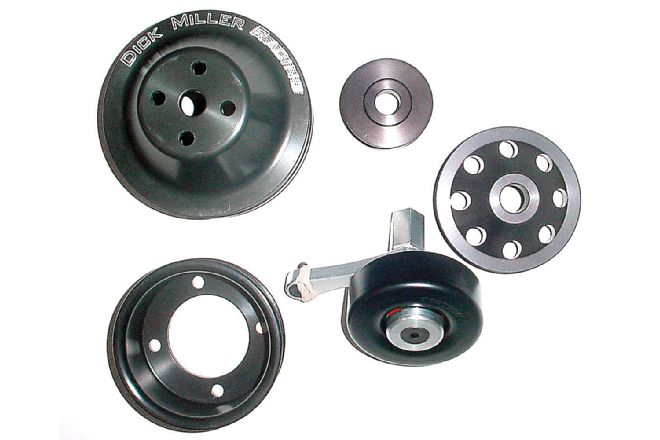 DMR’s five-piece serpentine kit (PN DMR 6065-5) includes (clockwise, from upper left) a water-pump pulley, an alternator pulley, a power-steering pump pulley, an idler that mounts near the power-steering pump, and a crankshaft pulley. Both standard-ratio and underdriven options are available. Pic: Dick Miller Racing
DMR’s five-piece serpentine kit (PN DMR 6065-5) includes (clockwise, from upper left) a water-pump pulley, an alternator pulley, a power-steering pump pulley, an idler that mounts near the power-steering pump, and a crankshaft pulley. Both standard-ratio and underdriven options are available. Pic: Dick Miller Racing
If you’d rather retain your old accessories and brackets, just driving them with a modern Poly-V belt, Dick Miller Racing (DMR) offers its $565-plus “pulley replacement system” that fits big- or small-block engines alike. According to Miller, “just pull off your old V-belt pulleys, and put on our serpentine pulleys and six-rib belt. This single belt drives the water pump, alternator, and power steering as a group, or any combination of these accessories. However, the single serpentine-style belt won’t drive the A/C, which is still driven off a V-belt via an extra groove on the rear of the new water-pump pulley. This lets you retain the old, big, GM A6 axial long compressor if desired. An idler pulley fastens near the power-steering pulley to generate adequate belt wrap. There is no separate tensioner—the alternator is the tensioner.” When ordering specify which style power-steering pulley your need: the keyed pulley retained on the shaft by a nut, or the later press-fit version.
The water pump rotation is conventional, permitting retention of original-type Olds V8 pumps. There have been at least three different Olds water pump snout-lengths: 5 inches, 59⁄16 inches, or 6 inches, as measured from the pump mounting surface to the front surface of the pump’s pulley hub. Miller’s kit is setup for the 6-inch pump, but includes a spacer for the 59⁄16-inch pump. The early ultrashort 5-inch pump (stock circa ’64) is not officially supported because (unlike the two longer pumps) spacers would be needed for all the other accessories, not just the water pump itself. But according to Miller, “the Olds harmonic balancer stick-outs are all the same,” so there’s no worries in that department.
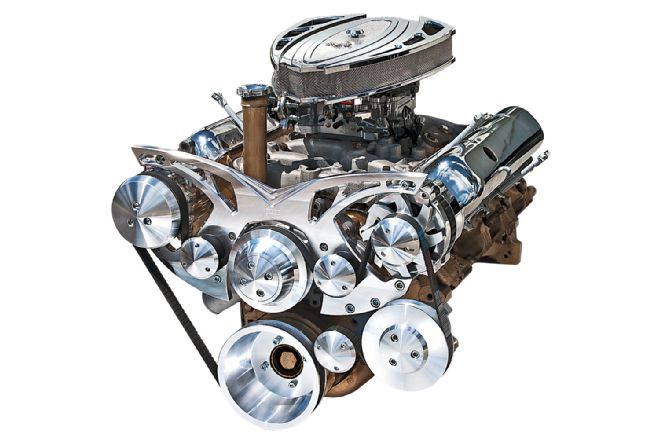 March’s Olds 350/455 Style Track setup is a one-stop solution for a complete Olds 350 or 455 serpentine-drive system with included modern accessories. Included are a new standard-rotation aluminum water pump, a 105-amp alternator, and a Sanden 7176 A/C compressor. Power steering using a Saginaw Type 2 pump with a remote reservoir is optional. Pic: March Performance
March’s Olds 350/455 Style Track setup is a one-stop solution for a complete Olds 350 or 455 serpentine-drive system with included modern accessories. Included are a new standard-rotation aluminum water pump, a 105-amp alternator, and a Sanden 7176 A/C compressor. Power steering using a Saginaw Type 2 pump with a remote reservoir is optional. Pic: March Performance
If a perfected V-belt setup is OK, Mondello offers a bolt-on billet aluminum V-belt drive system that supports Sanden A/C compressors, power steering, the alternator, and the water pump. These are precision, deep-groove pulleys that use Goodyear NASCAR V-belts (originally developed back in the day when the rules still required V-belts).
Ask Marlan A Tech Question: [email protected]